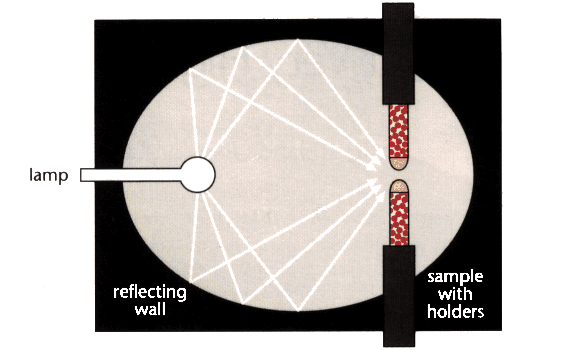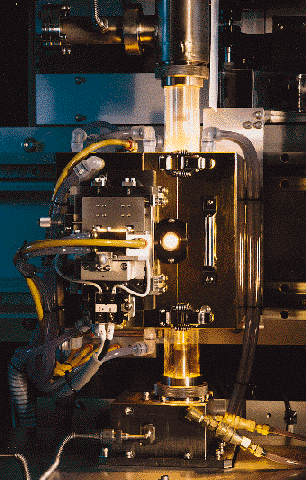![]()
The Ceramic Single-Crystal Growth Laboratory is dedicated to the growth of single crystals of inorganic materials by the floating-zone method.
The facility has recently been heavily used for research on tunable solid-state lasers; forsterite (Mg2SiO4) and Y3Al5O12 doped with Cr, as well as other cations, have been grown. Other crystals that have been grown successfully include CoO, Mn3O4, Fe3O4, NiAl2O4, Co2SiO4, Fe2SiO4, Mn2SiO4 and (Fe,Mg)2SiO4 (olivine). Growth rates vary between a few tenths of 1 mm/hour to about 10 mm/hour.
|
In the image furnace, ceramic material is formed into a single crystal |
|
|
A view of the furnace in operation. The sample is enclosed in quartz tube, which extends through the ellipsoidal mirror assembly. |
![]()
NEC Image Furnace (Model #SC-N35HS/50X) -- Operates in the range of 1000 to 2800 °C in controlled atmospheres. Heating is provided by either a halogen lamp (1.5 or 3.5 kW) or a xenon lamp (5.4 kW).

Figure 1. The ellipsoid mirror furnace.
A heat lamp is located at one of the two focal points of the ellipsoid, and the radiation is focused at the other focal point. Two holders allow sample rods to be advanced into this second focal-point region, where melting occurs. The sample rods are usually formed from pressed and subsequently sintered powder.
The water-cooled main body of the furnace is made of an aluminum alloy plated with gold for enhanced reflectivity and corrosion resistance. The furnace is equipped with two heat sources -- a 3.5 kW halogen lamp that can heat a cubic centimeter of sample as high as 2100 °C, and a 5.4 kW xenon high-pressure lamp to achieve temperatures up to 2800 °C. A tube of fused silica sealed into two chunks surrounding the sample protects the reflective mirror walls from evaporating sample compounds and allows the use of controlled gas atmospheres, which may be reducing or oxidizing.
Figure 2. The
growth of single crystals by the floating-zone method in the image furnace.
(For viewing
Fig. 2 in a larger size click on it.)
The sample material is in the form of rods contained in the movable sample holders shown in Figure 1.
a. The ends of the tow sample rods enter the hot zone, melt, and are pushed together to form a connection section of melt.
b. The two melt-connected rods are lowered slowly, initially at different velocities. As soon as the lower rod moves downward, melt begins to crystallize at the rod's upper surface, with the grains of the sintered powder acting as nuclei. If the lowering rate remains below a certain level (determined by the material), the grains simultaneously increase in size and decrease in number.
c. As the diameter of the growing rod is reduced to about 1-2 mm (by lowering the lower rod faster than the upper rod), grains are eliminated until only one large grain -- the desired singe crystal -- remains.
d. After that, varying the rates at which the rods are lowered allows the single crystal to grow in diameter to the final size, typically 5-10 mm; then the crystal of this diameter continues to grow in length as long as the feeding material -- the upper rod -- lasts.
Accessory Equipment -- Includes a gas mixing station with electronically controlled flow meters; a video recorder; an isostatic press for powder compaction; a high-temperature, controlled-atmosphere furnace for sintering the compacted powder to produce feeding rods for the single-crystal growth; temperature-measuring devices; and a diamond saw.
to page on research interests to page on special technical capabilities back to home page of the Dieckmann Group
last update: 09/25/2013

